Quick answer to the question posed above? Yes! In fact, we’ve done just this.
Learn more below, then give us a call or reach out online with questions.
Manufactured Fireplace to Gas Log Set Conversion
In this instance, we took a 20-25 year old manufactured metal fireplace and successfully upgraded it to a great-looking gas log fireplace. This included:
- replacing the worn out and cracked panels
- adding a new gas log set
- ensuring everything was functioning correctly
- matching new panels to meet the customer’s vision
What Are the Benefits of Gas-Fueled Fireplaces?
So why are so many, like this customer, making the switch to gas fireplaces?
- They’re easy to operate. With the simple flip of a switch or the press of a button, gas fireplaces ignite instantly, providing immediate warmth and ambiance.
- They require less fuel maintenance. Unlike wood-burning fireplaces, gas fireplaces do not require you to chop, store, or haul wood.
- You can control them with a remote. Many models come with remote controls, allowing you to adjust the flame, heat output, and even set timers – all from the comfort of your couch.
- They’re less messy. Gas fireplaces burn cleanly, producing no ash or soot, which means less mess and easier maintenance.
- They’re highly efficient. Gas fireplaces can convert a higher percentage of fuel into usable heat compared to wood-burning models, leading to better overall efficiency and heat output.
- They produce a controlled flame. The flame in a gas fireplace is controlled and contained, reducing the risk of sparks or embers causing a fire.
- Most have safety features. Many gas fireplaces are equipped with safety features such as automatic shut-off if the pilot light goes out or if the unit overheats.
- They come in a variety of styles. Gas fireplaces come in a wide range of styles and designs, from traditional to contemporary, allowing you to find one that fits your home’s decor, no problem.
- They look realistic. Modern gas fireplaces often feature realistic flames and logs, providing the look and feel of a traditional wood fire – without the hassle.
- They provide reliable, consistent heat. Gas fireplaces provide consistent heat output, which can be adjusted easily to maintain your desired comfort level.
Can Fireplace Refractory Panels Be Replaced?
Definitely! In fact, fireplace refractory panels are an essential component of a fireplace – designed to withstand high temperatures and protect the firebox from heat damage – so if you notice any damage, getting them replaced is highly encouraged.
What are signs refractory panels need replacing?
- Cracks & Chips: Small cracks can often be repaired, but larger cracks or missing pieces indicate the need for replacement.
- Warping or Bowing: Panels that have warped or bowed due to heat stress need to be replaced to ensure proper protection and efficiency.
- Surface Erosion: If the surface of the panels is eroding, they will not provide adequate protection and should be replaced.
In these cases, be sure to call us in, so that we can complete a thorough inspection to determine the full extent of your damage. We’ll then take accurate measurements of the existing area, carefully remove the damaged panels, then install new and improved ones in their place.
All in all, refectory panel replacement isn’t a service to put off. Intact panels are crucial for protecting the firebox and surrounding structures from excessive heat (thus reducing the risk of fire hazards), and they help to maintain the fireplace’s efficiency by reflecting heat back into the room and ensuring proper airflow.
Is DIY refractory panel replacement an option?
This isn’t something we would ever recommend. In fact, DIY-ing any fireplace or chimney project comes with significant risks. Remember that these systems are designed for containing flames and keeping noxious gases from entering your home. Even a small mistake or slip-up can lead to bigger issues that put your household at risk – or, at the minimum, cause further damage that costs you significant dollars down the line.
Hiring a professional ensures that the panels are installed correctly and safely. We have the necessary tools, experience, and knowledge to handle the replacement efficiently.
Looking To Convert Your Fireplace? We Can Help
Converting any fireplace – whether it’s a manufactured fireplace to a gas log set or something else – is typically a feasible and beneficial option for many homeowners…and it’s one we’re happy to help you with.
Whether you’re looking to reduce your environmental footprint, simplify your home heating, or update the look of your living space, we have excellent solutions that can bring your vision and goals to life. Consult with our experts to assess your specific fireplace and ensure a safe, efficient conversion that meets all necessary codes and standards.
We can’t wait to hear from you – reach out now.
Do you own a wood-burning fireplace, but aren’t loving the work and commitment required to operate it? There’s no denying a crackling fire enhances the atmosphere of your living space, especially when the weather is chillier, but if the effort of building and maintaining fire (plus all the clean-up afterwards) is putting a damper on your evenings, then it might be time to consider some updates.
One great option comes in the form of a gas fireplace insert. These units can be installed directly into your existing fireplace, leaving you with an easy and effective way to enhance your fireplace experience for many years to come.
Check out some of the many benefits of switching to a gas insert, then be sure to reach out to the team here at Lords Chimney with any questions or concerns. We’d love to help you out with it all!
Advantages of a Gas Fireplace Insert
Ready to reap the benefits of a gas insert? We don’t blame you – check out all you have to gain below.
- Heightened Efficiency: You won’t be short on heat with a gas fireplace insert. With wood-burning units, you tend to lose a lot of heat up the fireplace, but not with gas inserts. You’ll have a lot more heat radiated into your living space, allowing you to really cozy up – and save on energy bills while you’re at it.
- Great Ambiance: Gas fireplace inserts come in a wide range of styles, sizes, and designs, so you’re sure to find something you can love and that’s unique to your tastes and preferences.
- Low Maintenance: Gas inserts are known for being easier to maintain. They don’t require you to scoop ash, haul wood, or build and maintain a fire. As long as you’re investing in those annual professional inspections, you should be good to go!
- Easy to Operate: Not looking for much hassle at the end of a long day? With a gas insert, all you have to do is switch it on, and you’ve got a cozy aesthetic to relax in. No stress, no mess, and no extra work on your end!
- Minimal Mess: With gas inserts, there’s no dealing with a messy ash pile, and there’s zero risk of stray sparks and embers flying off and damaging floors and furniture. Also, since it doesn’t burn wood, you won’t have to deal with creosote buildup, either.
- Cleaner Burn: Inserts are known for burning cleaner and nowadays finding ones that meet or exceed Environmental Protection Agency (EPA) standards is never a problem. So, if you’re concerned about your carbon footprint, this is a great option!
Invest in a Professional Installation
Are you known for your DIY skills? If you tend to be handy around the home, you may be wondering if installing a gas insert is something you can do without the help of a professional sweep.
This isn’t something we recommend. Inserts are often advertised as being easy to install, but that doesn’t mean this process shouldn’t be completed by a professional. There are gas lines that need to be handled, as well as various other factors that will likely come into play, and all of these things should be done by someone who has been trained and educated. DIY attempts can lead to some dangerous scenarios for you and your household.
And don’t forget to make sure your sweep is Chimney Safety Institute of America (CSIA) certified, too! This ensures they put in the time and effort to be the best they can be by studying a long list of materials and taking an extensive exam. This certification needs to be renewed every 3 years, too, so rest assured, your sweep will always be up-to-date on any new industry news or advancements.
Need Gas Logs?
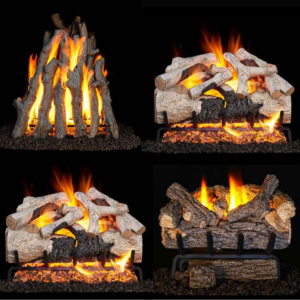 At Lords Chimney, we sell Peterson Real Fyre gas logs. These logs are known for their versatility, and they pour much less pollutants into the air than real wood logs. Whatever your needs and preferences are, whether that’s natural gas, liquid propane, vent-free, or vented, we’re certain we can find the perfect choice for you! In fact, vented options come in over 40 different realistic-looking style options, so you’re certain to find the right fit for your home, no problem.
At Lords Chimney, we sell Peterson Real Fyre gas logs. These logs are known for their versatility, and they pour much less pollutants into the air than real wood logs. Whatever your needs and preferences are, whether that’s natural gas, liquid propane, vent-free, or vented, we’re certain we can find the perfect choice for you! In fact, vented options come in over 40 different realistic-looking style options, so you’re certain to find the right fit for your home, no problem.
Don’t Wait to Reach Out
Here at Lords Chimney, we love setting homeowners up with the fireplace system they’ve been dreaming of. We’re home to Texas’s only CSIA Master Chimney Sweep, Lee Roff, we’re certified with National Fireplace Institute (NFI), and we’re members of National Chimney Sweep Guild (NCSG).
We pride ourselves on always putting your safety and satisfaction first, and we’re known for always staying on top of the latest techniques and technologies in the trade. Ask around or do an online search to see our reviews, and you’ll quickly realize that we’re highly esteemed throughout our service area. There’s no crew better to trust!
Whatever your gas fireplace or insert-related needs are, we want to help. We can even discuss options for installing one of these systems outdoors!
Give us a call or contact us online today, and we can get this process started. We look forward to speaking with you soon!
Year after year, sales of gas log fireplaces continue to increase. Homeowners love that they are easy to use, efficient, and have significantly lower maintenance costs than wood burning heating appliances. However, despite the relatively small amount of upkeep gas logs require, they can be damaged or deteriorate over time.
While gas create a clean burning and efficient heat, it can be dangerous if not used correctly. One of the most common problems with gas logs occur when homeowners continue to use them if they are damaged. If this happens, call Lords Chimney; we fix gas logs!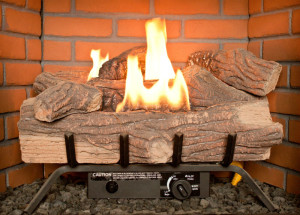
Gas log maintenance
Just like any other heating appliance, gas logs need regular upkeep and maintenance in order to keep working their best. Both the interior and exterior of the fireplace should be cleaned at least twice per year; doing this removes any dust or soot that may accumulate an impact gas log performance. When cleaning the inside of the gas log, use a clean, dry cloth or soft bristled paint brush. Care should be taken not to bump, move, or shift the gas log components as even movements as small as a few millimeters can impact performance.
In addition, the fireplace’s glass or metal exterior can be cleaned as often as needed to removes dust, handprints, or smudges. However, homeowners should try to use specialized cleaners as often as possible, even for the fireplace’s exterior; some commercial cleaners do not react well with the ambient heat from the fireplace.
For all gas log fireplaces, the user’s manual is one of the most invaluable resources a homeowner has. The manual will often have specific information on cleaning, operating, and maintaining your specific fireplace unit. If you think something is wrong with your gas log or have noticed a change in performance, your user’s manual may be able to provide you with troubleshooting questions or tips in order to help you identify the problem,
When do I need a chimney sweep?
While gas logs have much easier maintenance than other heating appliances, many homeowners are still surprised to learn that they still need to have their chimney swept each year! Gas logs can still suffer from the buildup of creosote – especially if they are not regularly swept; likewise, some high efficiency units are at higher risk for water condensation or incomplete combustion.
If at any time you begin to experience usage problems with your gas log, it is important to call a chimney sweep as soon as possible. Things like smoke production, an oddly colored flame, a strong gassy or smoky odor, or staining on your chimney’s exterior are all signs that your gas log may be experiencing a serious problem. If you experience these or any other unusual chimney symptoms, stop using your gas log immediately and call a chimney sweep.
With regular maintenance, your gas log can last for years to come. However, even regular maintenance doesn’t guarantee you won’t have a problem that needs professional attention. When you need your gas log fixed, contact Lords Chimney to have the job done right!
Gas fireplaces continue to grow in popularity due to their energy savings, ease of use, and low maintenance. Gas logs are particularly popular due to their ability to recreate the look and feel of a wood burning fire at the push of a button. While there is significantly less work with a gas fireplace compared to a wood burning one, gas fireplaces still need regular cleaning and upkeep.
Although gas logs do not have ashes or soot to remove after each use, they should be regularly cleaned to maintain efficiency and safety. Cleaning a gas log is an easy process, but special care should be taken to ensure that no fireplace parts or pieces are damaged.
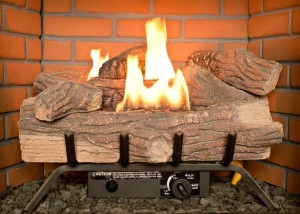
Cleaning your gas log
The interior and exterior portions of your gas log fireplace should be cleaned at least twice a year to prevent an excessive buildup of soot or dust. However, only cleaners that are specially designed for gas fireplaces should be used. Other chemical or homemade cleaning agents may have abrasive qualities on the gas, metal, or ceramic parts of the fireplace. In addition, the chemicals in non-fireplace cleaners may react when the fireplace is relit for use. A specialized cleaner can be purchased at many fireplace retailers.
The exterior glass and metal can be wiped down as often as needed using a clean, damp cloth or other specialized cleaner. The burners, control compartments, and ceramic logs can be gently cleaned with a dry cloth or soft bristled paintbrush. A vacuum may also be used, but can should be taken not to shift or move the gas log or its components.
Safety considerations
Before attempting to clean your gas logs, make sure that the gas valve has been completely shut off. Likewise, none of the fireplace components should be warm to the touch from recent use, as the heat may react negatively with the cleaners.
Referencing the manufacturer’s manual is another way to ensure that you are safely and correctly cleaning your fireplace logs and other components. The manual should give detailed instructions on how to safely clean the fireplace with minimal risks.
If you believe you have damaged any of the components of your gas log fireplace during cleaning, contact a professional before using the fireplace again. Even shifting a gas log a few inches can impact both performance and safety.
Do I need a chimney sweep?
Many homeowners are surprised to find that they still need their chimney swept after installing a gas log. Gas appliances still produce small amounts of creosote, which can coat the inside of the flue. In addition, high efficiency modern gas fireplaces are also at risk for incomplete combustion and water condensation.
An improperly sized chimney or flue cannot create sufficient drafting for a gas fireplace, leading to incomplete combustion. When this occurs, gasses such as carbon monoxide may linger in the fireplace. Likewise, accumulating water condensation can be corrosive to the flue lining.
Having a regular chimney cleaning and inspection can help protect your family against any emerging chimney or fireplace issues, as well as ensure that your gas fireplace is still running safely and efficiently. If you have questions about how to clean your gas fireplace or need to schedule a chimney inspection, contact Lord’s Chimney today!
Direct vent gas fireplaces have grown in popularity in recent years. With more realistic looking flames, a multitude of style options, and incredible ease of use, gas fireplaces allow families to enjoy the ambiance and warmth of a fire without the hassle and work associated with wood.
While gas fireplaces are more convenient and easy to use, they still have safety risks associated with them. A primary concern with gas fireplaces – especially in families with young children or pets – is the risk of burns associated with the hot glass fronts of the fireplace units.
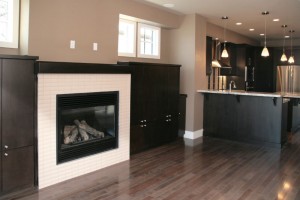
New fireplace safety standards
Beginning on January 1, 2015, all newly manufactured gas fireplaces and stoves with glass fronts will be required to include an installed protective barrier. This will apply to all appliances that have a glass surface temperature of 172 degrees or higher when in use.
“While gas fireplaces, stoves and inserts are a great asset to any home, the glass can become very hot during operation and stay hot long afterwards, creating a potential burn hazard,” said Hearth, Patio, and Barbeque Association president Jack Goldman. “In the past several years, there have been reports of burns involving young children and others who may not been aware of the potential risk of touching the hot glass on gas fireplaces, inserts and stoves. While we believe these incidents are few, even one is too many. We believe the new safety standard will provide greater protection to young children and others with special needs.”
This new standard was originally approved in 2012 by the American National Standards Institute. The U.S. Consumer Product Safety Commission worked with the fireplace and hearth industry to implement the standard in an effort to protect families from accidental burns. The standard will apply to all units manufactured after January 1, 2015. Retailers may continue to sell units manufactured before this date that do not meet the new safety standards.
Safety tips for families
If you have an existing gas appliance, there are a number of things you can do to protect yourself and your family from accidental burns. These common sense safety tips can help keep everyone in your home safe.
- Don’t leave children or pets unattended in front of a fireplace that is in use or has been turned off
- Teach children about fireplace safety and to never touch the glass of the fireplace
- Keep the remote control of the fireplace out of reach to prevent it from being accidentally turned on
- Install a switch lock to prevent children from turning on any gas appliances
Additional safety products
There are a number of safety products available to homeowners who already own gas appliances. Protective barriers or screens are the easiest and most common safety precaution. Safety screens come in a variety of styles and can be attached directly to the front of the fireplace or left as freestanding screens. Likewise, baby gates or barriers can be used to keep children and pets away from the fireplace when it is in use.
When installing aftermarket screens directly to the front of your hearth, please be aware that they may change the functionality of your fireplace. Check with a fireplace professional before installing something directly to the fireplace.
If you have questions about making your gas appliance safer, contact Lord’s Chimney today. Our expert staff is highly trained and ready to make sure you can enjoy your gas fireplace while keeping your family safe.
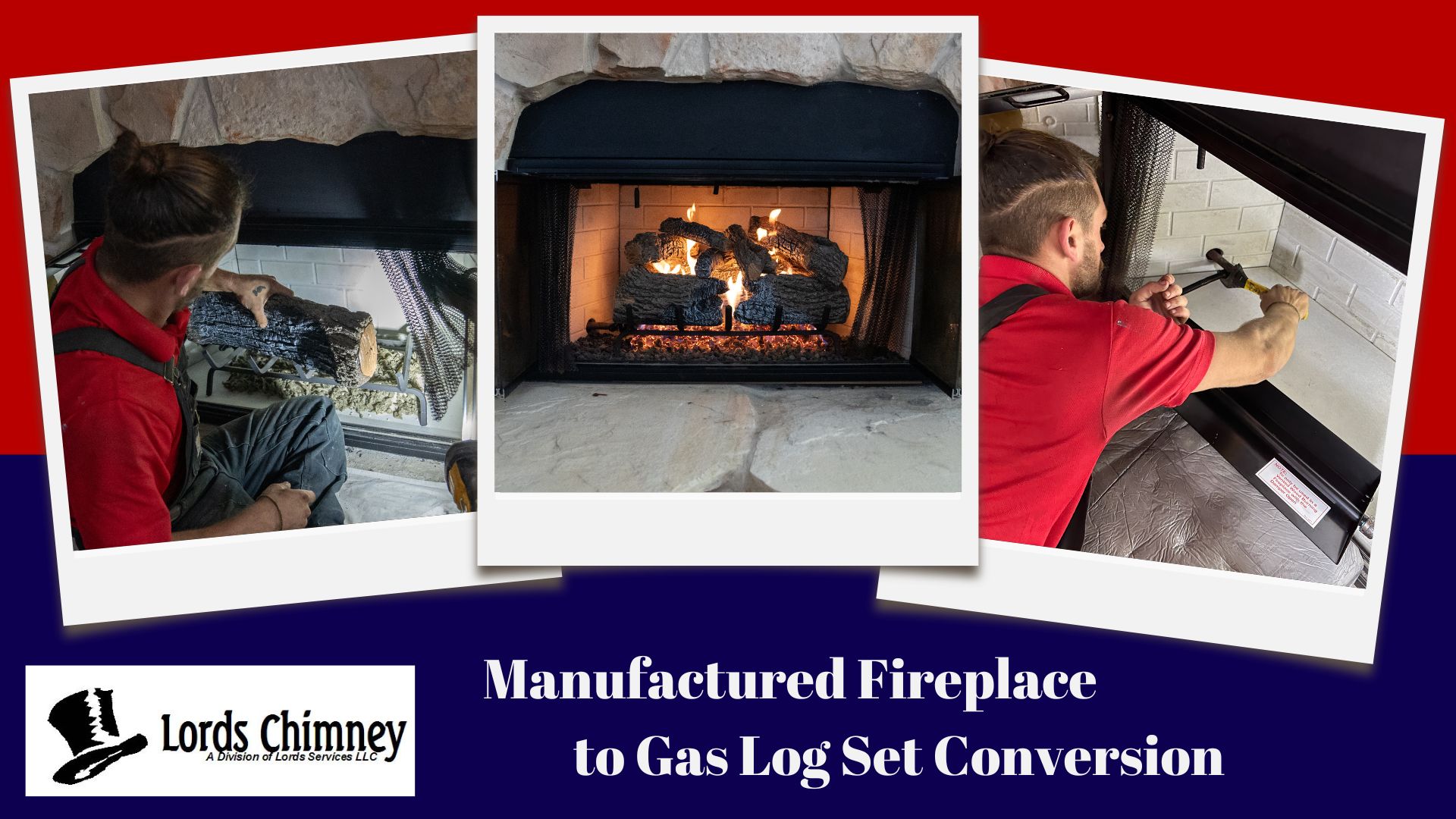


 At Lords Chimney, we sell
At Lords Chimney, we sell 

